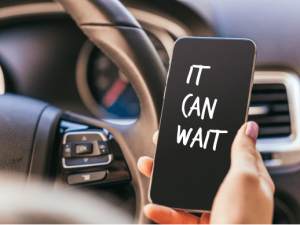 by HWC Partner Michael Eldridge
by HWC Partner Michael Eldridge
Over the past two decades, the cell phone has evolved into a vital extension of our daily lives. The smartphone is now how we respond to emails, listen to music, surf the Internet, take photographs, buy groceries, make dinner reservations, and much, much more. All this use creates an enormous amount of data about us. What most of us might not realize, however, is that all of this forensic evidence is stored right inside our device.
In recent years, parties in litigation regarding motor vehicle collisions have battled over the discoverability of this forensic evidence. The battle centers on two competing interests. The need to uncover relevant evidence versus a person’s right to privacy. As it relates to the former, it is unquestionable that cell phone evidence could lead to the discovery of important evidence. According to the nonpartisan Pew Research Center, as of early 2018, 95% of adults in the United States owned a cell phone,1 77% of which owned a smartphone.2 What has grown alongside these astonishing ownership rates is device capabilities. Smartphones today have what seems like infinite capabilities, which creates an infinite number of distractions. According to the National Safety Council, 25% of highway crashes in the United States are caused by distractions from the use of cellular phones and/or smart devices.3
In April 2017, Zendrive, a company which provides smartphone-powered road safety analytics, published a study of the interplay between phone use and distracted driving. The project examined three million drivers over a three-month period and found that 88% of drivers used their phones in some capacity while operating their vehicle.4 Additionally, the study showed drivers used their phones for about 3.5 minutes for every hour of driving. They determined that this conduct increased a driver’s risk of causing a collision by 20 times for every two seconds a driver does not have their eyes on the road.5 According to the National Highway Traffic Safety Administration’s Summary of Statistical Findings for 2015, some 391,000 people were injured in crashes involving distracted drivers, with 3,477 of those people sustaining fatal injuries.6
The mountain of statistical data tying cell phone use to the cause of highway collisions has thrust cellular forensic data to the forefront of electronic discovery. Litigators are routinely retaining cellular forensic experts to perform data extractions of smartphones. These forensic examinations uncover, among other things, all of a person’s cellular data usage, phone calls, text messages, GPS coordinates, application logs, etc. for any given time dating back to when the device was purchased. The examination is potentially vital to determine exactly what a motorist was doing at or around the time of the collision at issue. The data could show the precise times and locations a motorist was on the phone, texting, browsing the Internet, or using an application.
In Alabama, there is an extremely low bar for what constitutes relevant and discoverable evidence. Specifically, the Alabama Rules of Civil Procedures states parties are permitted to obtain discovery regarding any matter, not privileged, that is relevant to the subject matter involved in the pending case.7 As mentioned above, potential evidence shedding light on whether a driver was distract ed is relevant to the question of who caused a crash. The question facing the Courts, however, is whether the need for this evidence outweighs the potential risk of invading the other party’s right to privacy. Litigants opposing the discoverability of cellular forensic data examinations argue that because forensic cellular extractions require a complete dump of all the data from a person’s smartphone, they are an inherent invasion of privacy. Simply put, extracting years of personal information, the vast majority of which has no bearing on the case, is a massive intrusion into all facets of a person’s life and an unreasonable invasion of privacy.
ed is relevant to the question of who caused a crash. The question facing the Courts, however, is whether the need for this evidence outweighs the potential risk of invading the other party’s right to privacy. Litigants opposing the discoverability of cellular forensic data examinations argue that because forensic cellular extractions require a complete dump of all the data from a person’s smartphone, they are an inherent invasion of privacy. Simply put, extracting years of personal information, the vast majority of which has no bearing on the case, is a massive intrusion into all facets of a person’s life and an unreasonable invasion of privacy.
In weighing one party’s right to obtain relevant evidence with the other party’s right to privacy, courts are careful to ensure certain measures are taken to safeguard privacy interest prior to ordering a forensic cell phone examination. While there is no uniform rule governing the procedure for these extractions, certain practices exist for parties seeking and responding to this type of discovery request. This includes the parties creating protocols for the scope of the information extracted, entering into protective orders and confidentiality agreements, and agreeing to a third-party neutral expert to perform the forensic examination.
While discovery efforts related to smartphones can be complicated and are continuing to evolve, it is becoming commonplace in disputed liability car crash litigation. Litigants seeking and responding to these discovery efforts need to be mindful to both a party’s right to obtain relevant information and the risks associated with violating a party’s right to privacy and confidentiality. Prior to requesting a forensic examination of a smartphone, a party should take steps to narrow the scope of the request to relevant times and specific information. Prior to turning over these devices for the purpose of inspection, parties responding to this type of request need to make sure there are appropriate inspection protocols in place, including protective orders and confidentiality non-waiver agreements. Ultimately, the goal is to limit the discovery effort to relevant, non-privileged information while protecting the other party’s reasonable right to privacy.
If you or someone you love has been injured or killed at the hands of a distracted driver, call the Alabama personal injury attorneys at Hollis, Wright & Clay, P.C. at 844.LAW.TALK or 205.324.3600. You can reach us online here. We can help you recover damages for lost wages, medical bills, emotional distress, and more.
1 Mobile Fact Sheet, Pew Research Center (February 5, 2018).
2 Id. See also Aaron Smith, Record shares of Americans now own smartphones, have home broadband, Pew Research Center (Jan. 12, 2017.
3 Distracted Driver; North American Crash Statistics, National Safety Council (April 3, 2019).
4 Noah Budnik, Largest Distracted Driving Behavior Study, Zendrive (April 17, 2017).
5 Id.
6 U.S. Department of Transportation, National Highway Traffic Safety Administration, Research Note: Distracted Driving 2015 (March 2017).
7 Ala. R. Civ. P. 26(b)(1)(i).
 Alabama Injury Law Blog
Alabama Injury Law Blog

